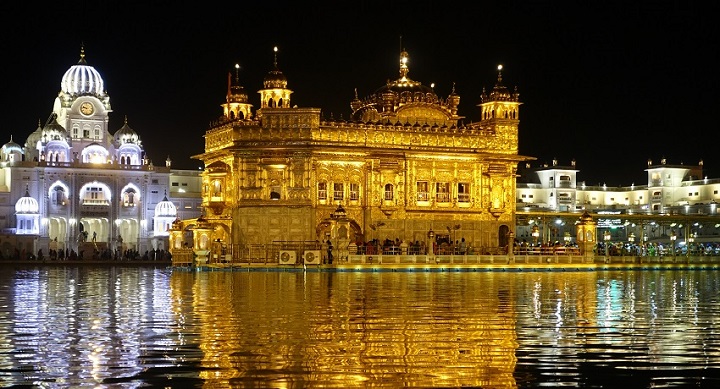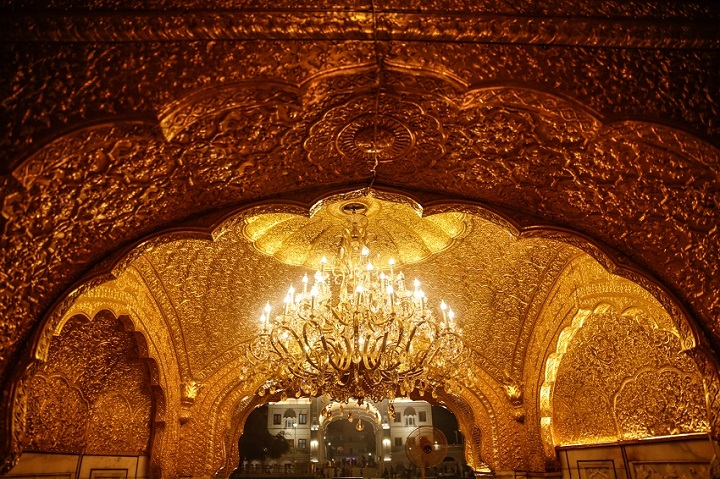The Golden Temple in Amritsar, Punjab is the supreme spiritual site of Sikhism. Renowned worldwide and known as the Harmandir Sahib, literally translated as “Abode of God”, is the Holy Gurudwara in the city of Amritsar in the northern State of Punjab in India.

The architectural holy structure was built at the centre of a man-made sarovar (lake) during the 15th Century. In the year 1577, the fourth Sikh Guru – Guru Ram Das completed the construction of the Gurudwara. In the year 1604, Guru Arjan placed a copy of the Adi Granth in Harmandir Sahib.

The Gurudwara has been rebuilt multiple times by various eminent Sikh leaders as it was destroyed several times by the Mughal and Afghan invaders. In the year 1809, having established the Sikh Empire, Maharaj Ranjit Singh rebuilt the Gurudwara in marble and copper. In the year 1830, the sanctum was overlaid with gold. The ancient India was popularly known as the ‘Sone ki Chidiya’ – Golden Bird!

Renowned as the Golden Temple, every walks of life and faiths visit this holy shrine in awe and solidarity of India as one. The master plan of the Golden Temple was designed in a square plot of land with four entrances and a circumambulation path around the pool. The Golden Temple Complex is a collection of buildings around the sanctum and the pool.

In the Golden Temple Complex, Akal Takht is the chief centre of the religious authority of Sikhism. A Clock Tower, Offices of the Gurudwara Committee, a priceless Museum and the Langar House are the main buildings completing the Golden Temple Complex. The Langar House serves more than 100,000 devotees Guru’s Prasad (unlimited vegetarian meals) daily without any discrimination 365 days of the year. The Langar House is run by the Sikh community.

It is interesting to note that the Golden Temple’s architecture reflects different architectural practices prevalent in the Indian subcontinent. The simple reasons being that the complex has had multiple iterations, as it was rebuilt and restored under various Sikh Gurus. One can see a touch of Indo-Islamic Mughal and the Hindu Rajput architecture styles, which makes the Golden Temple Complex unique in many ways.

A 12.25 x 12.25 sq. m sanctum with two storied and a gold foil dome was built on a 19.7 x 19.7 sq. m marble platform. The sanctum sits inside a nearly square pool of 154.5 x 148.5 sq. m known as amritsar or amritsarovar – ‘amrit’ = ‘nectar’ and ‘sar’ short form of ‘sarovar’ = ‘lake’.

The man-made lake is 5.1m deep. It is surrounded by a 3.7m wide circumambulatory marble passage that is circled clockwise. The sanctum is connected to the platform by a causeway. The gateway into the causeway is called the ‘darshani deorhi’ = ‘sighting door’.

Guru Granth Sahib – the Holy Sikh Scripture is seated on the square ground floor for nearly 20 hours of the day, every single day. For 4 hours, the Holy Scripture is taken to Akal Takht – its bedroom with elaborate ceremony in a ‘palki’ = ‘palanquin’ for ‘sukhasana’ = ‘relief’ and ‘prakash’ = light. The floor with the seated Holy Scripture is raised a few steps above the entrance causeway level.

In the sanctum, the upper floor acts as a gallery and is connected by a narrow staircase. The whole ground floor is lined with white marble along with the path surrounding the sanctum. Gilded with copper plates, the exterior of the sanctum shines brightly. The doors are gold foil covered copper sheets. It has beautiful natural motifs of birds and flowers.

The ceiling of the upper floor is magnificently gilded, embossed and decorated with jewels. The sanctum dome has been built in a semi-spherical shape and its pinnacle is ornamented. Covered with gold foil covered gilded copper, the sides are embellished with arched copings and small solid domes and the corners adorning cupolas.

It is really interesting to see the Arabesque floral designs on the marble panels of the walls around the sanctum. Verses from the Sikh scripture in gold letters adorn the arches. The frescoes depict Indian traditional designs of animals, birds and natural motifs. The stair walls are engraved with murals of Sikh Gurus. The four entrances to the Golden Temple Complex signify the ‘openness to all sides’.

The Golden Temple’s construction was first started by Guru Arjan in the year 1581. The man-made lake area was kept dry during the construction. In the year 1589, the first version of Harmandir Sahib was completed. The Gurudwara was planned at a lower level than the city to emphasize ‘humility’ and ‘the need to efface one’s ego’ before entering the place of worship to meet the Guru. It is such an interesting facet of ancient Indian architecture.

Photography: Johnny D